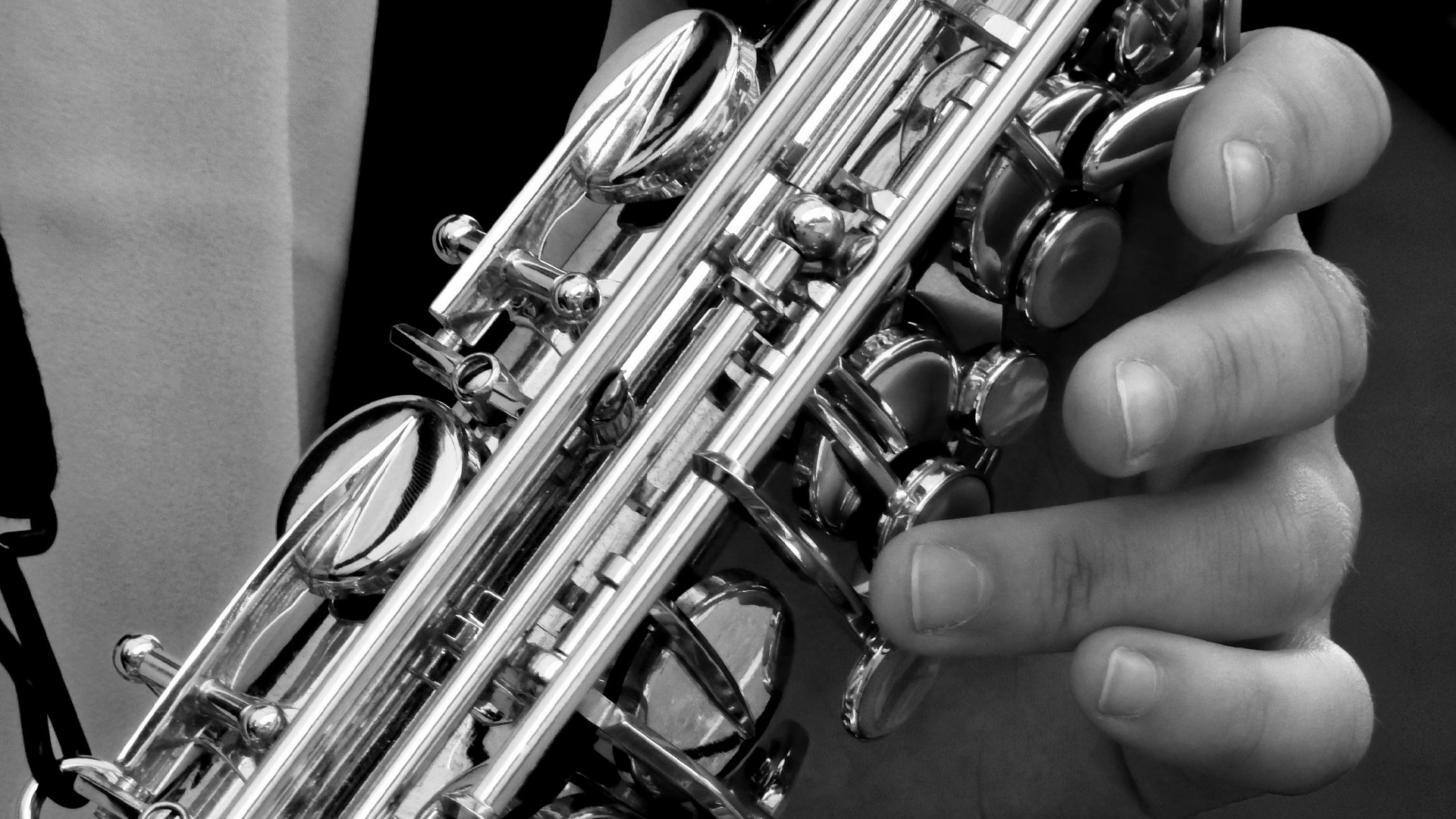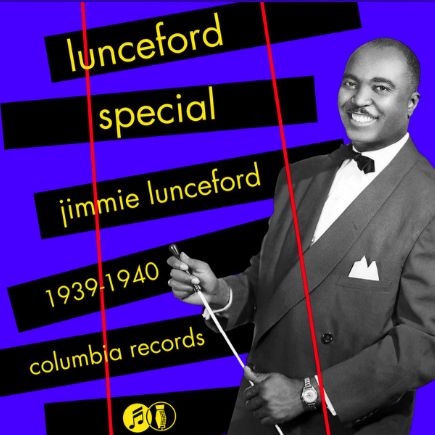Jimmie Lunceford, l’élégance disciplinée du swing orchestral
Chef d’orchestre, saxophoniste et arrangeur d’exception, Jimmie Lunceford s’impose dans les années 1930 et 1940 comme l’un des architectes du swing le plus raffiné et le plus exigeant. Né en 1902 à Fulton, dans le Mississippi, et élevé à Denver, Colorado, il développe très tôt une formation musicale solide sous la tutelle du pédagogue Wilberforce Whiteman, père du célèbre chef d’orchestre Paul Whiteman. Ce passage par l’enseignement académique marque profondément son rapport à la musique: rigueur, précision et exigence deviendront les maîtres-mots de sa carrière.
Diplômé de la Fisk University à Nashville, où il étudie la composition, la direction et plusieurs instruments à vent, Jimmie Lunceford enseigne d’abord la musique à Memphis. En 1927, il fonde avec ses élèves les Chickasaw Syncopators, formation bientôt rebaptisée Jimmie Lunceford Orchestra. Le groupe acquiert rapidement une réputation enviable grâce à un mélange inédit de discipline, d’humour et de virtuosité. Chaque prestation devient un spectacle total où la mise en scène rejoint la perfection musicale — un modèle de coordination et de professionnalisme rarement égalé à l’époque.
Sous sa direction, l’orchestre adopte un style immédiatement identifiable, fondé sur ce que les critiques appelleront le ‘tempo Lunceford’: un swing irrésistible en deux temps, d’une précision métronomique. Ce son repose sur des arrangements sophistiqués signés notamment par Sy Oliver et Eddie Durham, deux collaborateurs essentiels. Ensemble, ils façonnent un langage orchestral marqué par des riffs éclatants, des dialogues de sections d’une précision millimétrée et une énergie contagieuse.
Les années 1930 voient le Jimmie Lunceford Orchestra atteindre les sommets, rivalisant sur la scène du Cotton Club de Harlem avec des figures comme Duke Ellington ou Cab Calloway. Les titres Rhythm Is Our Business, For Dancers Only ou ’Tain’t What You Do (It’s the Way That You Do It) deviennent des emblèmes du swing, alliant sophistication harmonique et puissance rythmique. La presse et le public saluent alors une formation à la fois élégante et spectaculaire, où la musique se conjugue à une véritable chorégraphie de scène.
Mais derrière cette apparente légèreté, Jimmie Lunceford impose une discipline quasi militaire: ponctualité, sobriété et perfection d’exécution sont exigées de chaque musicien. Cette rigueur, parfois perçue comme autoritaire, assure néanmoins une cohésion sans faille et un niveau d’excellence constant. L’influence de Jimmie Lunceford dépasse largement sa propre formation. Glenn Miller, Tommy Dorsey et d’autres chefs d’orchestre reprendront ses principes d’arrangement et son sens du show.
Jimmie Lunceford, la elegancia disciplinada del swing orquestal
Director de orquesta, saxofonista y arreglista excepcional, Jimmie Lunceford se consolidó en las décadas de 1930 y 1940 como uno de los arquitectos más refinados y exigentes del swing. Nacido en 1902 en Fulton, Misisipi, y criado en Denver, Colorado, recibió una sólida formación musical bajo la tutela del pedagogo Wilberforce Whiteman, padre del célebre director Paul Whiteman. Aquella educación académica marcaría su relación con la música: rigor, precisión y exigencia serían las claves de toda su carrera.
Graduado en la Fisk University de Nashville, donde estudió composición, dirección y varios instrumentos de viento, Jimmie Lunceford comenzó enseñando música en Memphis. En 1927, fundó junto a sus alumnos los Chickasaw Syncopators, formación que pronto adoptaría el nombre Jimmie Lunceford Orchestra. El grupo alcanzó rápidamente una reputación destacada gracias a una combinación única de disciplina, humor y virtuosismo. Cada actuación era un espectáculo total en el que la puesta en escena se unía a la perfección musical: un modelo de coordinación y profesionalismo casi inédito para la época.
Bajo su dirección, la orquesta desarrolló un estilo inconfundible, basado en lo que los críticos denominaron el ‘tempo Lunceford’: un swing irresistible en dos tiempos, de precisión meticulosa. Este sonido se sustentaba en los sofisticados arreglos de Sy Oliver y Eddie Durham, colaboradores esenciales que contribuyeron a definir un lenguaje orquestal brillante, lleno de riffs dinámicos, contrastes precisos entre secciones y una energía contagiosa.
Durante los años treinta, la Jimmie Lunceford Orchestra alcanzó la cima del éxito, rivalizando en el Cotton Club de Harlem con figuras como Duke Ellington o Cab Calloway. Piezas como Rhythm Is Our Business, For Dancers Only o ’Tain’t What You Do (It’s the Way That You Do It) se convirtieron en himnos del swing, combinando sofisticación armónica y fuerza rítmica. La prensa y el público celebraban a una formación elegante y espectacular, donde la música se fundía con auténtica coreografía escénica.
Detrás de esta ligereza aparente se escondía una disciplina férrea: puntualidad, sobriedad y perfección en la ejecución eran requisitos innegociables. Esa exigencia, aunque a veces percibida como autoritaria, garantizó una cohesión impecable y un nivel de excelencia constante. La influencia de Jimmie Lunceford trascendió su propia orquesta: directores como Glenn Miller y Tommy Dorsey adoptaron su sentido del arreglo y su concepción del espectáculo.
Jimmie Lunceford, l’eleganza disciplinata dello swing orchestrale
Direttore d’orchestra, sassofonista e arrangiatore di eccezionale talento, Jimmie Lunceford si affermò negli anni Trenta e Quaranta come uno degli architetti più raffinati ed esigenti dello swing. Nato nel 1902 a Fulton, nel Mississippi, e cresciuto a Denver, in Colorado, ricevette una solida formazione musicale sotto la guida del pedagogo Wilberforce Whiteman, padre del celebre direttore Paul Whiteman. Questo percorso accademico segnò profondamente il suo rapporto con la musica: rigore, precisione ed esigenza divennero le parole chiave della sua carriera.
Laureato alla Fisk University di Nashville, dove studiò composizione, direzione e vari strumenti a fiato, Jimmie Lunceford iniziò insegnando musica a Memphis. Nel 1927 fondò con i suoi allievi i Chickasaw Syncopators, formazione che in seguito prese il nome di Jimmie Lunceford Orchestra. Il gruppo si fece rapidamente notare per una combinazione unica di disciplina, umorismo e virtuosismo. Ogni concerto era un vero spettacolo totale, dove la messa in scena si univa alla perfezione musicale — un modello di coordinazione e professionalità raramente eguagliato.
Sotto la sua direzione, l’orchestra sviluppò uno stile immediatamente riconoscibile, basato su quello che i critici chiamarono il ‘tempo Lunceford’: uno swing irresistibile in due tempi, di precisione quasi metronomica. Questo suono si fondava su arrangiamenti sofisticati firmati da Sy Oliver ed Eddie Durham, collaboratori fondamentali che contribuirono a creare un linguaggio orchestrale pieno di riff energici, dialoghi millimetrici tra le sezioni e un’energia trascinante.
Negli anni Trenta, la Jimmie Lunceford Orchestra raggiunse l’apice del successo, rivaleggiando al Cotton Club di Harlem con figure come Duke Ellington e Cab Calloway. Brani come Rhythm Is Our Business, For Dancers Only e ’Tain’t What You Do (It’s the Way That You Do It) divennero emblemi dello swing, unendo raffinatezza armonica e potenza ritmica. La stampa e il pubblico lodavano una formazione elegante e spettacolare, in cui la musica si trasformava in una vera coreografia di scena.
Dietro questa apparente leggerezza si celava una disciplina ferrea: puntualità, sobrietà e perfezione esecutiva erano obbligatorie per ogni musicista. Questa rigorosa professionalità, talvolta percepita come autoritaria, assicurò tuttavia una coesione impeccabile e uno standard di eccellenza costante. L’influenza di Jimmie Lunceford andò ben oltre la sua orchestra: direttori come Glenn Miller e Tommy Dorsey ne adottarono i principi di arrangiamento e il senso dello spettacolo.
Jimmie Lunceford, the disciplined elegance of orchestral swing
Bandleader, saxophonist, and arranger of exceptional talent, Jimmie Lunceford emerged in the 1930s and 1940s as one of the most refined and exacting architects of swing. Born in 1902 in Fulton, Mississippi, and raised in Denver, Colorado, he received a strong musical education under the guidance of the pedagogue Wilberforce Whiteman, father of the famed conductor Paul Whiteman. This academic foundation deeply shaped his relationship with music: rigor, precision, and high standards would define his entire career.
After graduating from Fisk University in Nashville, where he studied composition, conducting, and multiple wind instruments, Jimmie Lunceford began teaching music in Memphis. In 1927, he formed the Chickasaw Syncopators with his students, a group soon renamed the Jimmie Lunceford Orchestra. The ensemble quickly gained a stellar reputation thanks to its unique combination of discipline, humor, and virtuosity. Every performance was a complete show in which stagecraft met musical perfection—a model of coordination and professionalism rarely equaled at the time.
Under his direction, the orchestra developed a highly recognizable style based on what critics called the ‘Lunceford tempo’: an irresistible two-beat swing of metronomic precision. This sound was built on the sophisticated arrangements of Sy Oliver and Eddie Durham, key collaborators who helped craft an orchestral language full of brilliant riffs, tightly woven section dialogues, and infectious energy.
Throughout the 1930s, the Jimmie Lunceford Orchestra reached its peak, rivaling Duke Ellington and Cab Calloway on the Cotton Club stage in Harlem. Tracks like Rhythm Is Our Business, For Dancers Only, and ’Tain’t What You Do (It’s the Way That You Do It) became swing anthems, combining harmonic sophistication with rhythmic drive. Both the press and the public celebrated a band that was at once elegant and spectacular, where music and movement blended into choreographed artistry.
Behind this apparent ease, however, lay a strict discipline: punctuality, sobriety, and flawless execution were non-negotiable. Though sometimes viewed as authoritarian, Lunceford’s rigor ensured unshakable cohesion and consistent excellence. His influence extended far beyond his own orchestra—leaders like Glenn Miller and Tommy Dorsey would later adopt his principles of arrangement and showmanship.


